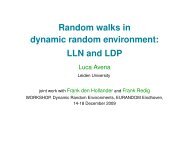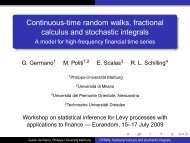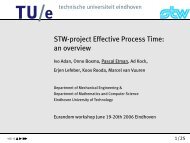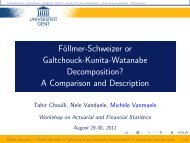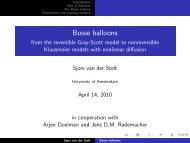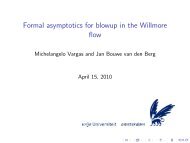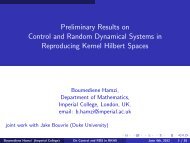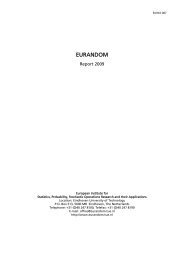Entropy Coherent and Entropy Convex Measures of Risk - Eurandom
Entropy Coherent and Entropy Convex Measures of Risk - Eurandom
Entropy Coherent and Entropy Convex Measures of Risk - Eurandom
Create successful ePaper yourself
Turn your PDF publications into a flip-book with our unique Google optimized e-Paper software.
<strong>Entropy</strong> <strong>Coherent</strong> <strong>and</strong> <strong>Entropy</strong> <strong>Convex</strong> <strong>Measures</strong> <strong>of</strong> <strong>Risk</strong><br />
Roger J. A. Laeven<br />
Dept. <strong>of</strong> Econometrics <strong>and</strong> OR<br />
Tilburg University, CentER<br />
<strong>and</strong> Eur<strong>and</strong>om<br />
based on joint work with<br />
Mitja Stadje<br />
January 19, 2011<br />
<strong>Entropy</strong> <strong>Coherent</strong> <strong>and</strong> <strong>Entropy</strong> <strong>Convex</strong> <strong>Measures</strong> <strong>of</strong> <strong>Risk</strong> Advances in Financial Mathematics, Eur<strong>and</strong>om, Eindhoven 1/40
1. Introduction<br />
Sign conventions used in this talk:<br />
◮ R<strong>and</strong>om variables represent pay<strong>of</strong>fs <strong>of</strong> financial positions. Positive<br />
realizations represent gains.<br />
◮ A risk measure represents a negative valuation.<br />
<strong>Entropy</strong> <strong>Coherent</strong> <strong>and</strong> <strong>Entropy</strong> <strong>Convex</strong> <strong>Measures</strong> <strong>of</strong> <strong>Risk</strong> Advances in Financial Mathematics, Eur<strong>and</strong>om, Eindhoven 2/40
<strong>Convex</strong> <strong>Measures</strong> <strong>of</strong> <strong>Risk</strong><br />
◮ <strong>Convex</strong> measures <strong>of</strong> risk (Föllmer <strong>and</strong> Schied, 2002, Fritelli <strong>and</strong> Rosazza<br />
Gianin, 2002, <strong>and</strong> Heath <strong>and</strong> Ku, 2004) are characterized by the axioms <strong>of</strong><br />
monotonicity, translation invariance <strong>and</strong> convexity.<br />
◮ They can (under additional assumptions on the space <strong>of</strong> r<strong>and</strong>om variables<br />
<strong>and</strong> on continuity properties <strong>of</strong> the risk measure) be represented in the<br />
form<br />
ρ(X) = sup {EQ [−X] − α(Q)},<br />
Q∈Q<br />
where Q is a set <strong>of</strong> probability measures <strong>and</strong> α is a penalty function<br />
defined on Q.<br />
◮ With<br />
α(Q) =0, if Q ∈ Q;<br />
∞, otherwise;<br />
we obtain the subclass <strong>of</strong> coherent measures <strong>of</strong> risk, represented in the<br />
form<br />
ρ(X) = sup<br />
Q∈M⊂Q<br />
EQ [−X] .<br />
<strong>Entropy</strong> <strong>Coherent</strong> <strong>and</strong> <strong>Entropy</strong> <strong>Convex</strong> <strong>Measures</strong> <strong>of</strong> <strong>Risk</strong> Advances in Financial Mathematics, Eur<strong>and</strong>om, Eindhoven 3/40
Variational Preferences<br />
◮ A rich paradigm for decision-making under ambiguity is the theory <strong>of</strong><br />
variational preferences (Maccheroni, Marinacci <strong>and</strong> Rustichini, 2006).<br />
◮ An economic agent evaluates the pay<strong>of</strong>f <strong>of</strong> a choice alternative (financial<br />
position) X according to<br />
U(X) = inf<br />
Q∈Q {EQ [u(X)] + α(Q)},<br />
where u : R → R is an increasing function, Q is a set <strong>of</strong> probability<br />
measures <strong>and</strong> α is an ambiguity index defined on Q.<br />
<strong>Entropy</strong> <strong>Coherent</strong> <strong>and</strong> <strong>Entropy</strong> <strong>Convex</strong> <strong>Measures</strong> <strong>of</strong> <strong>Risk</strong> Advances in Financial Mathematics, Eur<strong>and</strong>om, Eindhoven 4/40
Multiple Priors Preferences<br />
◮ A special case <strong>of</strong> interest is that <strong>of</strong> multiple priors preferences (Gilboa <strong>and</strong><br />
Schmeidler, 1989), obtained by considering<br />
U(X) = inf<br />
Q∈Q¨EQ [u(X)] + ĪM(Q)©,<br />
where ĪM is the ambiguity index that is zero if Q ∈ M <strong>and</strong> ∞ otherwise.<br />
◮ Gilboa <strong>and</strong> Schmeidler (1989) <strong>and</strong> Maccheroni, Marinacci <strong>and</strong> Rustichini<br />
(2006) established preference axiomatizations <strong>of</strong> these theories,<br />
generalizing Savage (1954) in the framework <strong>of</strong> Anscombe <strong>and</strong> Aumann<br />
(1963).<br />
◮ The representation <strong>of</strong> Gilboa <strong>and</strong> Schmeidler (1989), also referred to as<br />
maxmin expected utility, was a decision-theoretic foundation <strong>of</strong> the<br />
classical decision rule <strong>of</strong> Wald (1950) — see also Huber (1981) — that<br />
had long seen little popularity outside (robust) statistics.<br />
<strong>Entropy</strong> <strong>Coherent</strong> <strong>and</strong> <strong>Entropy</strong> <strong>Convex</strong> <strong>Measures</strong> <strong>of</strong> <strong>Risk</strong> Advances in Financial Mathematics, Eur<strong>and</strong>om, Eindhoven 5/40
Interpretation<br />
◮ The function u, referred to as a utility function, represents the agent’s<br />
attitude towards wealth.<br />
◮ The set Q represents the set <strong>of</strong> priors held by agents.<br />
◮ Under multiple priors preferences, the degree <strong>of</strong> ambiguity is reflected by<br />
the multiplicity <strong>of</strong> the priors.<br />
◮ Under general variational preferences, the degree <strong>of</strong> ambiguity is reflected<br />
by the multiplicity <strong>of</strong> the priors <strong>and</strong> the esteemed plausibility <strong>of</strong> the prior<br />
as reflected in the ambiguity index (or penalty function).<br />
<strong>Entropy</strong> <strong>Coherent</strong> <strong>and</strong> <strong>Entropy</strong> <strong>Convex</strong> <strong>Measures</strong> <strong>of</strong> <strong>Risk</strong> Advances in Financial Mathematics, Eur<strong>and</strong>om, Eindhoven 6/40
Homothetic Preferences<br />
◮ Recently, Chateauneuf <strong>and</strong> Faro (2010) <strong>and</strong>, slightly more generally,<br />
Cerreia-Vioglio et al. (2008) axiomatized a multiplicative analog <strong>of</strong><br />
variational preferences, referred to henceforth as homothetic preferences.<br />
◮ It is represented as<br />
with β : Q → [0, ∞].<br />
U(X) = inf<br />
Q∈Q {β(Q)EQ [u(X)]} , (1)<br />
◮ It also includes multiple priors as a special case (β(Q) ≡ 1).<br />
<strong>Entropy</strong> <strong>Coherent</strong> <strong>and</strong> <strong>Entropy</strong> <strong>Convex</strong> <strong>Measures</strong> <strong>of</strong> <strong>Risk</strong> Advances in Financial Mathematics, Eur<strong>and</strong>om, Eindhoven 7/40
Measuring ‘<strong>Risk</strong>’ (in the broad sense)<br />
◮ To measure the ‘risk’ related to a financial position X, the theories <strong>of</strong><br />
variational <strong>and</strong> homothetic preferences sketched above would lead to the<br />
definition <strong>of</strong> a loss functional L(X) = −U(X), satisfying<br />
L(X) = sup {EQ [φ(−X)] − α(Q)} <strong>and</strong><br />
Q∈Q<br />
L(X) = sup {β(Q)EQ [φ(−X)]} ,<br />
Q∈Q<br />
respectively, where φ(x) = −u(−x).<br />
◮ One could, then, look at the amount <strong>of</strong> capital one needs to hold in<br />
response to the position X, i.e., the negative certainty equivalent <strong>of</strong> X,<br />
denoted by mX, satisfying L(−mX) = φ(mX) = L(X), or equivalently,<br />
mX = φ −1sup {EQ [φ(−X)] − α(Q)}<strong>and</strong><br />
Q∈Q<br />
mX = φ −1sup {β(Q)EQ [φ(−X)]}.<br />
Q∈Q<br />
<strong>Entropy</strong> <strong>Coherent</strong> <strong>and</strong> <strong>Entropy</strong> <strong>Convex</strong> <strong>Measures</strong> <strong>of</strong> <strong>Risk</strong> Advances in Financial Mathematics, Eur<strong>and</strong>om, Eindhoven 8/40
Variational <strong>and</strong> Homothetic Preferences vs. <strong>Convex</strong> <strong>Measures</strong> <strong>of</strong> <strong>Risk</strong><br />
◮ Compare<br />
mX = φ −1sup {EQ [φ(−X)] − α(Q)}<strong>and</strong><br />
Q∈Q<br />
mX = φ −1sup {β(Q)EQ [φ(−X)]}<br />
Q∈Q<br />
to<br />
ρ(X) = sup {EQ [−X] − α(Q)}.<br />
Q∈Q<br />
◮ Question: find sufficient <strong>and</strong> necessary conditions.<br />
<strong>Entropy</strong> <strong>Coherent</strong> <strong>and</strong> <strong>Entropy</strong> <strong>Convex</strong> <strong>Measures</strong> <strong>of</strong> <strong>Risk</strong> Advances in Financial Mathematics, Eur<strong>and</strong>om, Eindhoven 9/40
Multiple Priors Preferences vs. <strong>Convex</strong> <strong>Measures</strong> <strong>of</strong> <strong>Risk</strong><br />
◮ Compare<br />
to<br />
mX = φ −1sup EQ [φ(−X)],<br />
Q∈M⊂Q<br />
ρ(X) = sup {EQ [−X] − α(Q)}.<br />
Q∈Q<br />
◮ Question: find sufficient <strong>and</strong> necessary conditions.<br />
<strong>Entropy</strong> <strong>Coherent</strong> <strong>and</strong> <strong>Entropy</strong> <strong>Convex</strong> <strong>Measures</strong> <strong>of</strong> <strong>Risk</strong> Advances in Financial Mathematics, Eur<strong>and</strong>om, Eindhoven 10/40
Question Rephrased [1]<br />
◮ In other words, we consider<br />
with<br />
ρ(X) = φ −1 (¯ρ(−φ(−X))),<br />
¯ρ(X) = sup<br />
Q∈M⊂Q<br />
EQ [−X] .<br />
◮ Preferences <strong>of</strong> Gilboa <strong>and</strong> Schmeidler (1989).<br />
◮ We also consider<br />
with<br />
ρ(X) = φ −1 (¯ρ(−φ(−X))),<br />
¯ρ(X) = sup {EQ [−X] − α(Q)}.<br />
Q∈Q<br />
◮ Preferences <strong>of</strong> Maccheroni, Marinacci <strong>and</strong> Rustichini (2006).<br />
◮ In the latter case, negative certainty equivalents are invariant under<br />
translation <strong>of</strong> u (or φ).<br />
◮ Traditionally (in the models <strong>of</strong> Savage, 1954, <strong>and</strong> Gilboa <strong>and</strong> Schmeidler,<br />
1989), negative certainty equivalents are invariant under both translation<br />
<strong>and</strong> positive multiplication <strong>of</strong> u (or φ).<br />
<strong>Entropy</strong> <strong>Coherent</strong> <strong>and</strong> <strong>Entropy</strong> <strong>Convex</strong> <strong>Measures</strong> <strong>of</strong> <strong>Risk</strong> Advances in Financial Mathematics, Eur<strong>and</strong>om, Eindhoven 11/40
Question Rephrased [2]<br />
◮ We consider in addition<br />
with<br />
with β : M → [0, 1].<br />
ρ(X) = φ −1 (¯ρ(−φ(−X))),<br />
¯ρ(X) = sup<br />
Q∈M⊂Q<br />
β(Q)EQ [−X] ,<br />
◮ Preferences <strong>of</strong> Chateauneuf <strong>and</strong> Faro (2010).<br />
◮ With ¯ρ as given above, negative certainty equivalents are invariant under<br />
positive multiplication <strong>of</strong> u (or φ); complementary case.<br />
◮ β : M → [0,1] can be viewed as a discount factor; ¯ρ seems natural.<br />
◮ Includes multiple priors preferences as a special case.<br />
◮ Recall question: find sufficient <strong>and</strong> necessary conditions under which ρ<br />
(not ¯ρ) is a convex risk measure.<br />
<strong>Entropy</strong> <strong>Coherent</strong> <strong>and</strong> <strong>Entropy</strong> <strong>Convex</strong> <strong>Measures</strong> <strong>of</strong> <strong>Risk</strong> Advances in Financial Mathematics, Eur<strong>and</strong>om, Eindhoven 12/40
Results [1]<br />
The contribution <strong>of</strong> this paper is tw<strong>of</strong>old.<br />
◮ First we derive precise connections between risk measurement under the<br />
theories <strong>of</strong> variational, homothetic <strong>and</strong> multiple priors preferences on the<br />
one h<strong>and</strong> <strong>and</strong> risk measurement using convex measures <strong>of</strong> risk on the<br />
other.<br />
◮ This is, despite the vast literature on both paradigms, a hitherto open<br />
problem.<br />
◮ In particular, we identify two subclasses <strong>of</strong> convex risk measures that we<br />
call entropy coherent <strong>and</strong> entropy convex measures <strong>of</strong> risk, <strong>and</strong> that<br />
include all coherent risk measures.<br />
◮ We show that, under technical conditions, negative certainty equivalents<br />
under variational, homothetic, <strong>and</strong> multiple priors preferences are<br />
translation invariant if <strong>and</strong> only if they are convex, entropy convex, <strong>and</strong><br />
entropy coherent measures <strong>of</strong> risk, respectively.<br />
<strong>Entropy</strong> <strong>Coherent</strong> <strong>and</strong> <strong>Entropy</strong> <strong>Convex</strong> <strong>Measures</strong> <strong>of</strong> <strong>Risk</strong> Advances in Financial Mathematics, Eur<strong>and</strong>om, Eindhoven 13/40
Results [2]<br />
◮ It entails that convex, entropy convex <strong>and</strong> entropy coherent measures <strong>of</strong><br />
risk induce linear or exponential utility functions in the theories <strong>of</strong><br />
variational, homothetic <strong>and</strong> multiple priors preferences.<br />
◮ We show further that, under a normalization condition, this<br />
characterization remains valid when the condition <strong>of</strong> translation invariance<br />
is replaced by requiring convexity.<br />
◮ The mathematical details in the pro<strong>of</strong>s <strong>of</strong> these characterization results are<br />
delicate.<br />
<strong>Entropy</strong> <strong>Coherent</strong> <strong>and</strong> <strong>Entropy</strong> <strong>Convex</strong> <strong>Measures</strong> <strong>of</strong> <strong>Risk</strong> Advances in Financial Mathematics, Eur<strong>and</strong>om, Eindhoven 14/40
Results [3]<br />
◮ These connections suggest two new subclasses <strong>of</strong> convex risk measures:<br />
entropy coherent <strong>and</strong> entropy convex measures <strong>of</strong> risk, <strong>and</strong> our second<br />
contribution is to study their properties.<br />
◮ We show that they satisfy many appealing properties.<br />
◮ We prove various results on the dual conjugate function for entropy<br />
coherent <strong>and</strong> entropy convex measures <strong>of</strong> risk. We show in particular that,<br />
quite exceptionally, the dual conjugate function can explicitly be identified<br />
under some technical conditions.<br />
◮ We also study entropy coherent <strong>and</strong> entropy convex measures <strong>of</strong> risk under<br />
the assumption <strong>of</strong> distribution invariance. Due to their convex nature, a<br />
feature that singles out entropy convex measures <strong>of</strong> risk in the class <strong>of</strong><br />
negative certainty equivalents under homothetic preferences, we can<br />
obtain explicit representation results in this setting.<br />
◮ Some financial applications <strong>and</strong> examples <strong>of</strong> these risk measures are also<br />
provided, explicitly utilizing some <strong>of</strong> the representation results derived.<br />
<strong>Entropy</strong> <strong>Coherent</strong> <strong>and</strong> <strong>Entropy</strong> <strong>Convex</strong> <strong>Measures</strong> <strong>of</strong> <strong>Risk</strong> Advances in Financial Mathematics, Eur<strong>and</strong>om, Eindhoven 15/40
Outline<br />
1. Introduction<br />
2. Entropic <strong>Measures</strong> <strong>of</strong> <strong>Risk</strong><br />
3. Characterization Results<br />
4. Duality Results<br />
5. Distribution Invariant Representation<br />
6. Applications <strong>and</strong> Examples<br />
7. Conclusions<br />
<strong>Entropy</strong> <strong>Coherent</strong> <strong>and</strong> <strong>Entropy</strong> <strong>Convex</strong> <strong>Measures</strong> <strong>of</strong> <strong>Risk</strong> Advances in Financial Mathematics, Eur<strong>and</strong>om, Eindhoven 16/40
2. Entropic <strong>Measures</strong> <strong>of</strong> <strong>Risk</strong> [1]<br />
We fix a probability space (Ω, F, P) <strong>and</strong> fix a scalar γ ∈ [0, ∞]. Let X ∈ L ∞ .<br />
Define<br />
eγ(X) := γ logEexp− X<br />
γ.<br />
◮ Entropic measures <strong>of</strong> risk (exponential premiums) emerge in various<br />
paradigms.<br />
<strong>Entropy</strong> <strong>Coherent</strong> <strong>and</strong> <strong>Entropy</strong> <strong>Convex</strong> <strong>Measures</strong> <strong>of</strong> <strong>Risk</strong> Advances in Financial Mathematics, Eur<strong>and</strong>om, Eindhoven 17/40
Entropic <strong>Measures</strong> <strong>of</strong> <strong>Risk</strong> [2]<br />
◮ Note that for every given X, the mapping γ → eγ(X) is increasing.<br />
◮ As is well-known (Csiszár, 1975),<br />
eγ(X) = sup<br />
¯P≪PÒE¯P [−X] − γH( ¯ P|P)Ó,<br />
where H(¯P|P) is the relative entropy, i.e.,<br />
H( ¯ ¯P<br />
if<br />
P|P) =E¯Plogd dP, ¯ P ≪ P;<br />
∞, otherwise.<br />
The relative entropy is also known as the Kullback-Leibler divergence; it<br />
measures the distance between the distributions ¯ P <strong>and</strong> P.<br />
<strong>Entropy</strong> <strong>Coherent</strong> <strong>and</strong> <strong>Entropy</strong> <strong>Convex</strong> <strong>Measures</strong> <strong>of</strong> <strong>Risk</strong> Advances in Financial Mathematics, Eur<strong>and</strong>om, Eindhoven 18/40
Two Interpretations<br />
1. Kullback-Leibler. The parameter γ may be viewed as measuring the degree<br />
<strong>of</strong> trust the agent puts in the reference measure P. If γ = 0, then<br />
e0(X) = −ess inf X, which corresponds to a maximal level <strong>of</strong> distrust; in<br />
this case only the zero sets <strong>of</strong> the measure P are considered reliable. If, on<br />
the other h<strong>and</strong>, γ = ∞, then e∞(X) = −E[X], which corresponds to a<br />
maximal level <strong>of</strong> trust in the measure P.<br />
2. Exponential utility. An economic agent with a CARA (exponential) utility<br />
function u(x) = 1 − e − x γ computes the (negative) certainty equivalent or<br />
applies the (negative) equivalent utility principle to the pay<strong>of</strong>f X with<br />
respect to the reference measure P.<br />
<strong>Entropy</strong> <strong>Coherent</strong> <strong>and</strong> <strong>Entropy</strong> <strong>Convex</strong> <strong>Measures</strong> <strong>of</strong> <strong>Risk</strong> Advances in Financial Mathematics, Eur<strong>and</strong>om, Eindhoven 19/40
Other Reference Measure<br />
In certain situations the agent could consider other reference measures Q ≪ P.<br />
Then we define the entropy eγ,Q with respect to Q as<br />
eγ,Q(X) = γ logEQexp−X γ.<br />
<strong>Entropy</strong> <strong>Coherent</strong> <strong>and</strong> <strong>Entropy</strong> <strong>Convex</strong> <strong>Measures</strong> <strong>of</strong> <strong>Risk</strong> Advances in Financial Mathematics, Eur<strong>and</strong>om, Eindhoven 20/40
<strong>Entropy</strong> Coherence <strong>and</strong> <strong>Entropy</strong> <strong>Convex</strong>ity<br />
Definition<br />
We call a mapping ρ : L ∞ → R γ-entropy coherent, γ ∈ [0, ∞], if there exists a<br />
set M ⊂ Q such that<br />
ρ(X) = sup eγ,Q(X).<br />
Q∈M<br />
It will be interesting to consider as well a more general class <strong>of</strong> risk measures:<br />
Definition<br />
The mapping ρ : L ∞ → R is γ-entropy convex, γ ∈ [0, ∞], if there exists a<br />
penalty function c : Q → [0, ∞] with infQ∈Q c(Q) = 0, such that<br />
ρ(X) = sup {eγ,Q(X) − c(Q)}.<br />
Q∈Q<br />
<strong>Entropy</strong> <strong>Coherent</strong> <strong>and</strong> <strong>Entropy</strong> <strong>Convex</strong> <strong>Measures</strong> <strong>of</strong> <strong>Risk</strong> Advances in Financial Mathematics, Eur<strong>and</strong>om, Eindhoven 21/40
Again Two Interpretations [1]<br />
Suppose that the agent is only interested in downside tail risk <strong>and</strong> considers<br />
Tail-Value-at-<strong>Risk</strong> (TV@R) defined by<br />
It is well-known that<br />
TV@R α (X) = 1<br />
αα<br />
0<br />
V@R λ (X)dλ, α ∈]0, 1].<br />
TV@R α (X) = sup EQ [−X] ,<br />
Q∈Mα<br />
where Mα is the set <strong>of</strong> all probability measures Q ≪ P such that dQ<br />
dP<br />
≤ 1<br />
α .<br />
<strong>Entropy</strong> <strong>Coherent</strong> <strong>and</strong> <strong>Entropy</strong> <strong>Convex</strong> <strong>Measures</strong> <strong>of</strong> <strong>Risk</strong> Advances in Financial Mathematics, Eur<strong>and</strong>om, Eindhoven 22/40
Again Two Interpretations [2]<br />
The economic agent may, however, not fully trust the probabilistic model <strong>of</strong> X<br />
under P, hence under Q. Therefore, for every fixed Q, the agent considers the<br />
supremum over all measures absolutely continuous with respect to Q, where<br />
measures that are ‘close’ to Q are esteemed more plausible than measures that<br />
are ‘distant’ from Q. This leads to a risk measure ρ given by<br />
ρ(X) = sup<br />
¯P≪Q Q∈Mα<br />
sup {E¯P [−X] − γH( ¯ P|Q)} = sup<br />
¯P≪P Q∈Mα<br />
= sup sup {E¯P [−X] − γH(¯P|Q)} = sup eγ,Q(X),<br />
Q∈Mα ¯P≪P<br />
Q∈Mα<br />
sup {E¯P [−X] − γH( ¯ P|Q)}<br />
where we have used in the second <strong>and</strong> last equalities that H(¯P|Q) = ∞ if ¯P is<br />
not absolutely continuous with respect to Q.<br />
<strong>Entropy</strong> <strong>Coherent</strong> <strong>and</strong> <strong>Entropy</strong> <strong>Convex</strong> <strong>Measures</strong> <strong>of</strong> <strong>Risk</strong> Advances in Financial Mathematics, Eur<strong>and</strong>om, Eindhoven 23/40
Again Two Interpretations [3]<br />
The definition <strong>of</strong> entropy convexity (whence the special case <strong>of</strong> entropy<br />
coherence as well) can also be motivated using microeconomic theory, as<br />
follows:<br />
◮ An economic agent with a CARA (exponential) utility function<br />
u(x) = 1 − e − x γ computes the certainty equivalent to the pay<strong>of</strong>f X with<br />
respect to the reference measure P.<br />
◮ The agent is, however, uncertain about the probabilistic model under the<br />
reference measure, <strong>and</strong> therefore takes the infimum over all probability<br />
measures Q absolutely continuous with respect to P, where the penalty<br />
function c(Q) represents the esteemed plausibility <strong>of</strong> the probabilistic<br />
model under Q.<br />
◮ The robust certainty equivalent thus computed is precisely −ρ(X).<br />
<strong>Entropy</strong> <strong>Coherent</strong> <strong>and</strong> <strong>Entropy</strong> <strong>Convex</strong> <strong>Measures</strong> <strong>of</strong> <strong>Risk</strong> Advances in Financial Mathematics, Eur<strong>and</strong>om, Eindhoven 24/40
A Basic Duality Result<br />
Define<br />
<strong>and</strong><br />
Then the following result holds:<br />
ρ ∗ (Q) = sup<br />
X ∈L∞ {eγ,Q(X) − ρ(X)}<br />
ρ ∗∗ (X) = sup {eγ,Q(X) − ρ<br />
Q≪P<br />
∗ (Q)}.<br />
Lemma<br />
A normalized mapping ρ is γ-entropy convex if <strong>and</strong> only if ρ ∗∗ = ρ.<br />
Furthermore, ρ ∗ is the minimal penalty function.<br />
<strong>Entropy</strong> <strong>Coherent</strong> <strong>and</strong> <strong>Entropy</strong> <strong>Convex</strong> <strong>Measures</strong> <strong>of</strong> <strong>Risk</strong> Advances in Financial Mathematics, Eur<strong>and</strong>om, Eindhoven 25/40
Subdifferential<br />
◮ We define the subdifferential <strong>of</strong> ρ by<br />
∂ρ(X) = {Q ∈ Q|ρ(X) = EQ [−X] − α(Q)}.<br />
We say that ρ is subdifferentiable if for every X ∈ L ∞ we have ∂ρ(X) = ∅.<br />
◮ For a γ-entropy convex function ρ we define by<br />
∂entropyρ(X) = {Q ∗ ∈ Q|ρ(X) = eγ,Q ∗(X) − c(Q ∗ )}<br />
the entropy subdifferential. Furthermore, if for every X ∈ L ∞ ,<br />
∂entropyρ(X) = ∅, then we say that ρ is entropy subdifferentiable.<br />
<strong>Entropy</strong> <strong>Coherent</strong> <strong>and</strong> <strong>Entropy</strong> <strong>Convex</strong> <strong>Measures</strong> <strong>of</strong> <strong>Risk</strong> Advances in Financial Mathematics, Eur<strong>and</strong>om, Eindhoven 26/40
3. Characterization Results [1]<br />
Recall the first question asked in the Introduction (slide 11). Answer:<br />
Theorem<br />
Suppose that the probability space is rich. Let φ be a strictly increasing <strong>and</strong><br />
continuous function satisfying 0 ∈ closure(Image(φ)), φ(∞) = ∞ <strong>and</strong><br />
φ ∈ C 3 (]φ −1 (0), ∞[).<br />
Then the following statements are equivalent:<br />
(i) ρ(X) = φ −1 (¯ρ(−φ(−X))) is translation invariant <strong>and</strong> the subdifferential <strong>of</strong><br />
¯ρ is always nonempty.<br />
(ii) ρ is γ-entropy coherent with γ ∈]0, ∞], <strong>and</strong> the entropy subdifferential is<br />
always nonempty.<br />
<strong>Entropy</strong> <strong>Coherent</strong> <strong>and</strong> <strong>Entropy</strong> <strong>Convex</strong> <strong>Measures</strong> <strong>of</strong> <strong>Risk</strong> Advances in Financial Mathematics, Eur<strong>and</strong>om, Eindhoven 27/40
Characterization Results [2]<br />
Recall the question asked in the Introduction (slide 12). Answer:<br />
Theorem<br />
Suppose that the probability space is rich. Let φ be a strictly increasing <strong>and</strong><br />
continuous function satisfying 0 ∈ closure(Image(φ)), φ(∞) = ∞ <strong>and</strong><br />
φ ∈ C 3 (]φ −1 (0), ∞[).<br />
Then the following statements are equivalent:<br />
(i) ρ(X) = φ −1 (¯ρ(−φ(−X))) is translation invariant <strong>and</strong> the subdifferential <strong>of</strong><br />
¯ρ is always nonempty.<br />
(ii) ρ is γ-entropy convex with γ ∈ R + or ρ is ∞-entropy coherent, <strong>and</strong> the<br />
entropy subdifferential is always nonempty.<br />
<strong>Entropy</strong> <strong>Coherent</strong> <strong>and</strong> <strong>Entropy</strong> <strong>Convex</strong> <strong>Measures</strong> <strong>of</strong> <strong>Risk</strong> Advances in Financial Mathematics, Eur<strong>and</strong>om, Eindhoven 28/40
Remark 1<br />
◮ The case that ρ is entropy convex corresponds to ρ being the negative<br />
certainty equivalent <strong>of</strong> ¯ρ(X) = sup Q∈M β(Q)EQ [−X], where<br />
β : M → [0,1] can be viewed as a discount factor, <strong>and</strong> with φ being linear<br />
(implying β(Q) ≡ 1) or exponential.<br />
◮ In this case, every model Q is discounted by a factor β(Q) corresponding<br />
to its esteemed plausibility.<br />
◮ If β(Q) = 1 for all Q ∈ M, we are back in the framework <strong>of</strong><br />
Gilboa-Schmeidler.<br />
◮ However, if there exists a Q ∈ M such that β(Q) < 1, ρ is entropy convex<br />
with γ ∈ R + but not entropy coherent.<br />
<strong>Entropy</strong> <strong>Coherent</strong> <strong>and</strong> <strong>Entropy</strong> <strong>Convex</strong> <strong>Measures</strong> <strong>of</strong> <strong>Risk</strong> Advances in Financial Mathematics, Eur<strong>and</strong>om, Eindhoven 29/40
Remark 2<br />
◮ Recall the definition <strong>of</strong> entropy convexity (slide 21).<br />
◮ As e∞,Q(X) = EQ [−X] , ρ is a convex risk measure if <strong>and</strong> only if it is<br />
∞-entropy convex.<br />
◮ As we will see later, however, with γ < ∞, not every convex risk measure<br />
is γ-entropy convex.<br />
◮ This is important: we have seen that, under some technical conditions,<br />
negative certainty equivalents under homothetic preferences are translation<br />
invariant if <strong>and</strong> only if they are γ-entropy convex with γ ∈ R + or<br />
∞-entropy coherent, ruling out the general ∞-entropy convex case.<br />
◮ Translation invariant negative certainty equivalents under homothetic<br />
preferences do not span the class <strong>of</strong> convex risk measures.<br />
<strong>Entropy</strong> <strong>Coherent</strong> <strong>and</strong> <strong>Entropy</strong> <strong>Convex</strong> <strong>Measures</strong> <strong>of</strong> <strong>Risk</strong> Advances in Financial Mathematics, Eur<strong>and</strong>om, Eindhoven 30/40
Characterization Results [3]<br />
Recall the second question asked in the Introduction (slide 11). Answer:<br />
Theorem<br />
Suppose that the probability space is rich. Let φ be a strictly increasing <strong>and</strong><br />
convex function with φ ∈ C 3 (R) <strong>and</strong> either φ(−∞) = −∞ or<br />
limx→∞ φ(x)/x = ∞.<br />
Then the following statements are equivalent:<br />
(i) ρ(X) = φ −1 (¯ρ(−φ(−X))) is translation invariant <strong>and</strong> the subdifferential <strong>of</strong><br />
¯ρ is always nonempty.<br />
(ii) ρ is a convex risk measure <strong>and</strong> the subdifferential is always nonempty.<br />
<strong>Entropy</strong> <strong>Coherent</strong> <strong>and</strong> <strong>Entropy</strong> <strong>Convex</strong> <strong>Measures</strong> <strong>of</strong> <strong>Risk</strong> Advances in Financial Mathematics, Eur<strong>and</strong>om, Eindhoven 31/40
Another Characterization Result<br />
Reconsider the question asked in the Introduction (slide 12). Another answer:<br />
Theorem<br />
Suppose that the probability space is rich. Let φ be a strictly increasing <strong>and</strong><br />
continuous function satisfying 0 ∈ closure(Image(φ)), φ(∞) = ∞ <strong>and</strong><br />
φ ∈ C 3 (]φ −1 (0), ∞[).<br />
Then the following statements are equivalent:<br />
(i) ρ(X) = φ −1 (¯ρ(−φ(−X))) is convex, ρ(m) = −m for all m ∈ R <strong>and</strong> the<br />
subdifferential <strong>of</strong> ¯ρ is always nonempty.<br />
(ii) ρ is γ-entropy convex with γ ∈ R + or ρ is ∞-entropy coherent, <strong>and</strong> the<br />
entropy subdifferential is always nonempty.<br />
<strong>Entropy</strong> <strong>Coherent</strong> <strong>and</strong> <strong>Entropy</strong> <strong>Convex</strong> <strong>Measures</strong> <strong>of</strong> <strong>Risk</strong> Advances in Financial Mathematics, Eur<strong>and</strong>om, Eindhoven 32/40
4. Duality Results [1]<br />
Recall that if ρ is a convex risk measure then (under additional continuity<br />
assumptions) there exists a unique α : Q → R ∪ {∞}, referred to as the dual<br />
conjugate <strong>of</strong> ρ, such that the following dual representation holds:<br />
with<br />
ρ(X) = sup<br />
Q∈QÒEQ [−X] − α(Q)Ó,<br />
α(Q) = sup<br />
X ∈L ∞ÒEQ [−X] − ρ(X)Ó.<br />
<strong>Entropy</strong> <strong>Coherent</strong> <strong>and</strong> <strong>Entropy</strong> <strong>Convex</strong> <strong>Measures</strong> <strong>of</strong> <strong>Risk</strong> Advances in Financial Mathematics, Eur<strong>and</strong>om, Eindhoven 33/40
Duality Results [2]<br />
Theorem<br />
Suppose that ρ is γ-entropy convex with penalty function c. Then:<br />
(i) The dual conjugate <strong>of</strong> ρ, is given by the largest convex <strong>and</strong><br />
lower-semicontinuous function α being dominated by<br />
infQ∈Q{γH(¯P|Q) + c(Q)}.<br />
(ii) If c is convex <strong>and</strong> lower-semicontinuous, then α is the largest<br />
lower-semicontinuous function being dominated by<br />
infQ∈Q{γH( ¯ P|Q) + c(Q)}.<br />
(iii) If c is convex <strong>and</strong> lower-semicontinuous, <strong>and</strong> satisfies additional<br />
integrability conditions (see paper), then the conjugate dual<br />
α( ¯ P) = min<br />
Q∈Q {γH(¯ P|Q) + c(Q)}.<br />
<strong>Entropy</strong> <strong>Coherent</strong> <strong>and</strong> <strong>Entropy</strong> <strong>Convex</strong> <strong>Measures</strong> <strong>of</strong> <strong>Risk</strong> Advances in Financial Mathematics, Eur<strong>and</strong>om, Eindhoven 34/40
5. Distribution Invariant Representation [1]<br />
◮ Let<br />
Ψ = {ψ : [0, 1] → [0, 1]<br />
|ψ is concave, right-continuous at zero with ψ(0+) = 0 <strong>and</strong> ψ(1) = 1}.<br />
◮ For ψ ∈ Ψ <strong>and</strong> X ∈ L ∞ we define Eψ [X] :=ÊXdψ(P).<br />
◮ Furthermore, we define<br />
eγ,ψ(X) := γ logEψexp−X<br />
eγ,ψ(P)(X).<br />
γ=:<br />
<strong>Entropy</strong> <strong>Coherent</strong> <strong>and</strong> <strong>Entropy</strong> <strong>Convex</strong> <strong>Measures</strong> <strong>of</strong> <strong>Risk</strong> Advances in Financial Mathematics, Eur<strong>and</strong>om, Eindhoven 35/40
Distribution Invariant Representation [2]<br />
Theorem<br />
Suppose that ρ is γ-entropy convex. Then the following statements are<br />
equivalent:<br />
(i) ρ is distribution invariant.<br />
(ii) ρ(X) = sup ψ∈Ψ {eγ,ψ(X) − (ρ ∗ ) ′ (ψ)} with<br />
(ρ ∗ ) ′ (ψ) = sup X ∈L ∞ {eγ,ψ(X) − ρ(X)}.<br />
<strong>Entropy</strong> <strong>Coherent</strong> <strong>and</strong> <strong>Entropy</strong> <strong>Convex</strong> <strong>Measures</strong> <strong>of</strong> <strong>Risk</strong> Advances in Financial Mathematics, Eur<strong>and</strong>om, Eindhoven 36/40
6.1 <strong>Risk</strong> Sharing<br />
◮ Suppose that there are two economic agents A <strong>and</strong> B measuring risk using<br />
a general entropy convex measure <strong>of</strong> risk ρ A <strong>and</strong> ρ B with γ A , γ B ∈ R + .<br />
◮ Let ¯ρ = −ρ, ēγ,Q = −eγ,Q <strong>and</strong> ¯c = −c.<br />
◮ Suppose that A owns a financial pay<strong>of</strong>f X A <strong>and</strong> B owns a financial pay<strong>of</strong>f<br />
X B .<br />
◮ We solve explicitly the problem <strong>of</strong> optimal risk sharing given by<br />
R A,B (X A ,X B ) = sup<br />
F ∈L∞ {¯ρ A (X A − F + Π F ) + ¯ρ B (X B + F − Π F )}<br />
= sup<br />
¯F ∈L∞ {¯ρ A (X A + X B − ¯ F) + ¯ρ B ( ¯ F)} =: ¯ρ A ¯ρ B (X A + X B ),<br />
where Π F is the agreed price <strong>of</strong> the financial derivative (risk transfer) F<br />
<strong>and</strong> where we have set ¯F := F + X B .<br />
◮ In particular, under technical conditions (see paper), the optimal risk<br />
sharing is attained in the derivative F ∗ = γB<br />
γ A +γ B X A − γA<br />
γ A +γ B X B .<br />
<strong>Entropy</strong> <strong>Coherent</strong> <strong>and</strong> <strong>Entropy</strong> <strong>Convex</strong> <strong>Measures</strong> <strong>of</strong> <strong>Risk</strong> Advances in Financial Mathematics, Eur<strong>and</strong>om, Eindhoven 37/40
6.2 Portfolio Optimization <strong>and</strong> Indifference Valuation [1]<br />
◮ Let F be a bounded contingent claim.<br />
◮ Consider a Brownian-Poisson setting: we assume that the financial market<br />
consists <strong>of</strong> a bond with interest rate zero <strong>and</strong> n ≤ d stocks. The price<br />
process <strong>of</strong> stock i evolves according to<br />
dS i t<br />
Si = b<br />
t−<br />
i tdt + σ i tdWt +Rd′ ˜β<br />
\{0}<br />
i t(x) Ñp(dt,dx), i = 1, . . . , n,<br />
where b i (σ i , ˜ β i ) are R (R d , R)-valued predictable <strong>and</strong> uniformly bounded<br />
stochastic processes.<br />
<strong>Entropy</strong> <strong>Coherent</strong> <strong>and</strong> <strong>Entropy</strong> <strong>Convex</strong> <strong>Measures</strong> <strong>of</strong> <strong>Risk</strong> Advances in Financial Mathematics, Eur<strong>and</strong>om, Eindhoven 38/40
Portfolio Optimization <strong>and</strong> Indifference Valuation [2]<br />
◮ Using BSDEs, we solve explicitly the following optimization problem:<br />
ˆV γ (x) := sup<br />
inf<br />
Q∈M<br />
π∈Ã<br />
−γ logEQexp− 1<br />
γx +T<br />
0<br />
dSt<br />
πt<br />
St−<br />
+ F,<br />
where x is the initial wealth, the process π i t describes the amount <strong>of</strong> money<br />
invested in stock i at time t, <strong>and</strong> M is a set <strong>of</strong> measures equivalent to P.<br />
◮ Note the generality: robust, constraints <strong>and</strong> jumps.<br />
<strong>Entropy</strong> <strong>Coherent</strong> <strong>and</strong> <strong>Entropy</strong> <strong>Convex</strong> <strong>Measures</strong> <strong>of</strong> <strong>Risk</strong> Advances in Financial Mathematics, Eur<strong>and</strong>om, Eindhoven 39/40
5. Conclusions<br />
◮ We have introduced two new classes <strong>of</strong> risk measures: entropy coherent<br />
<strong>and</strong> entropy convex measures <strong>of</strong> risk.<br />
◮ We have demonstrated that convex, entropy convex <strong>and</strong> entropy coherent<br />
measures <strong>of</strong> risk emerge as translation invariant certainty equivalents<br />
under variational, homothetic <strong>and</strong> multiple priors preferences, respectively,<br />
<strong>and</strong> induce linear or exponential utility functions in these paradigms.<br />
◮ A variety <strong>of</strong> representation <strong>and</strong> duality results as well as some applications<br />
<strong>and</strong> examples have made explicit that entropy coherent <strong>and</strong> entropy<br />
convex measures <strong>of</strong> risk satisfy many appealing properties.<br />
◮ The theory developed in this paper is <strong>of</strong> a static nature. In future research<br />
we intend to develop its dynamic counterpart.<br />
<strong>Entropy</strong> <strong>Coherent</strong> <strong>and</strong> <strong>Entropy</strong> <strong>Convex</strong> <strong>Measures</strong> <strong>of</strong> <strong>Risk</strong> Advances in Financial Mathematics, Eur<strong>and</strong>om, Eindhoven 40/40


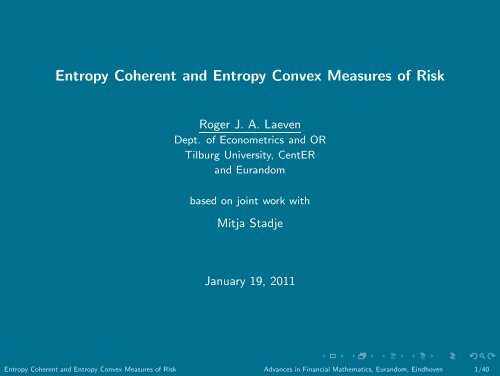
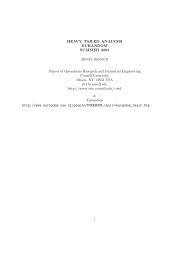
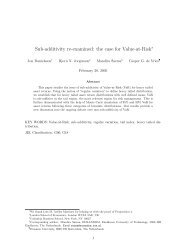
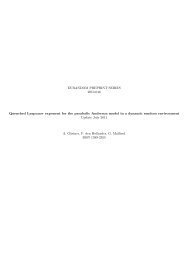
![The Contraction Method on C([0,1]) and Donsker's ... - Eurandom](https://img.yumpu.com/19554492/1/190x143/the-contraction-method-on-c01-and-donskers-eurandom.jpg?quality=85)
